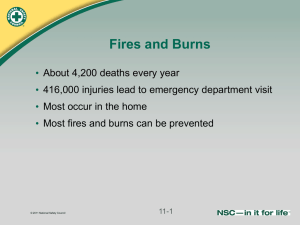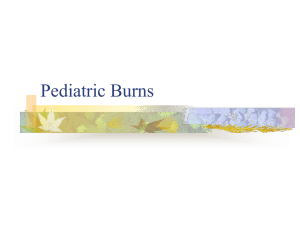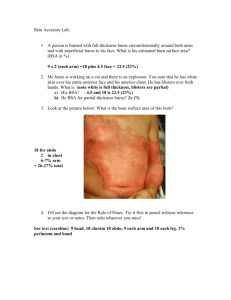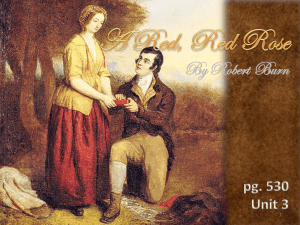Literacy Across the Curriculum
advertisement
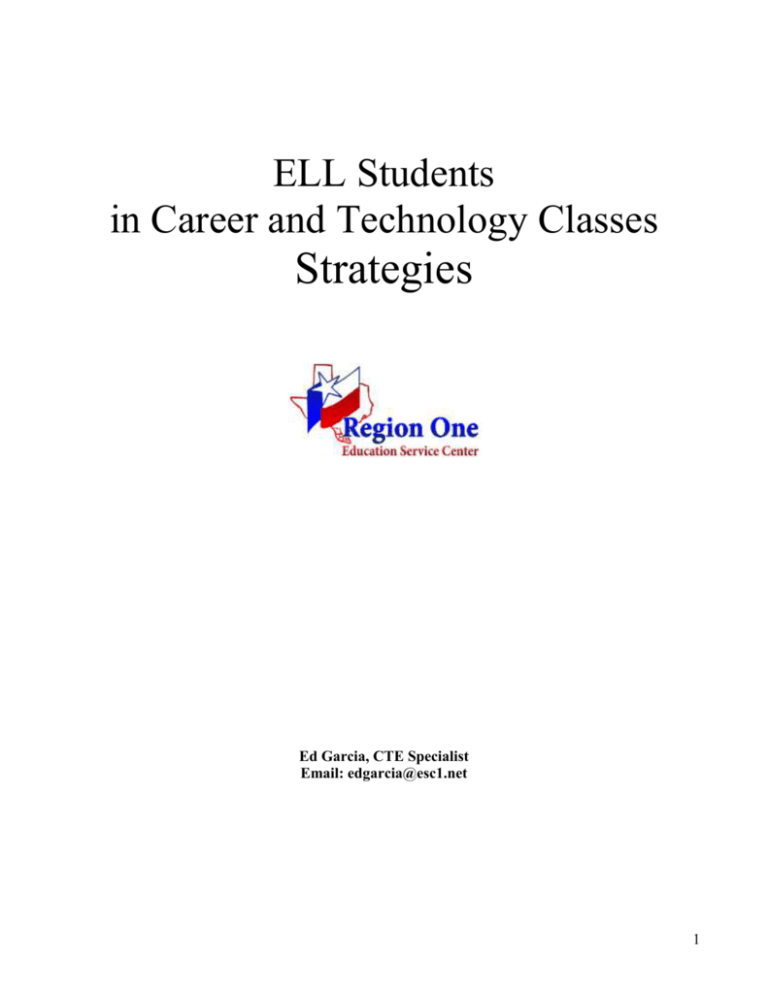
ELL Students in Career and Technology Classes Strategies Ed Garcia, CTE Specialist Email: edgarcia@esc1.net 1 Recognizing Content Vocabulary ABC2 Literacy A Analyze: (Take the word/concept apart; look at its parts) Apply: (Apply what we know about the parts to gain an understanding of the word or concept) B C Compare: Brainstorm: (Draw on previous knowledge; pose questions about the word or concept) (What does this word or concept remind me of? What is it like?) Bridge: Contrast: (Make connections between ideas brainstormed above and the meaning of the word or concept; ask what can I infer?) 2 (How is it different, distinct from something else in its category?) Concept Definition Map What is it? What is it like? Literacy What are some examples? 3 For information on the Concept Definition Map, see Literacy Across the Curriculum, pages 116. Frayer Model Characteristics Examples Non-characteristics Literacy For information on the Frayer Model, see Literacy Across the Curriculum, pages 120 4 Non-examples The Big Six Reading Skills Linked to Literacy Across the Curriculum Skill Teaching Strategy Source Summarizing Jigsaw Paired Questioning GIST KWL Cornell Notes Reciprocal Teaching Pg. 61 Pg. 61 Pg. 62 Pg. 105 Pg. 121 Pg. 123 Paraphrasing Jigsaw Paired Questioning KWL Cornell Notes Pg. 61 Pg. 61 Pg. 105 Pg. 121 Categorizing KWL Graphic Organizers Concept Definition Map Frayer Model Cornell Notes Pg. 105 Pg. 114 Pg. 115 Pg. 119 Pg. 121 Inferring RAFT Questioning the Author Pg. 110 Pg. 117 Predicting KWL Story Impressions Anticipation Guides Visual Prediction Guide Reciprocal Teaching Pg. 105 Pg. 110 Pg. 113 Pg. 121 Pg. 123 Recognizing Academic Vocabulary Vocabulary Clues Concept Definition Map Mathematics Reading Keys Frayer Model Pg. 63 Pg. 114 Pg. 118 Pg. 119 5 Generating Interactive Schemata from Text Honda Fit Sport Honda’s smallest and cheapest car may be one of its best. It’s fun to drive, reliable and, for its size, very roomy. Then there’s the fuel economy: The Fit’s mileage has been all over the map. Press gently on the gas pedal around town and set the cruise control to 60 mph on the freeway and the results are surprisingly Prius-like. But try to keep up with the rest of the manic traffic flow in Los Angeles and fuel economy can dip into the high 20’s. That happens more often than not because the Fit has to use all of its 109 hp to merge onto the freeway. The swing in mileage from our best tankful to our worst was nearly 16 mpg—more than any other long-term test car in recent memory. __________________ __________________ _________________ __________________ __________________ __________________ _________________ __________________ __________________ __________________ _________________ __________________ __________________ __________________ _________________ __________________ __________________ __________________ _________________ __________________ Nonetheless, over the past 9000-plus miles, the Fit has been nearly bulletproof. Our only repair was the replacement of warped front brake rotors—the result of a frisky afternoon of canyon carving. We simply overheated the brakes and failed to cool them down properly. It was clearly our fault, yet the Honda dealership still replaced them under warranty. Stewart, Ben. “Long-Term Test Cars.” POPULAR MECHANICS June 2007: 58. __________________ __________________ _________________ __________________ __________________ __________________ _________________ __________________ __________________ __________________ _________________ __________________ __________________ __________________ _________________ __________________ __________________ __________________ _________________ __________________ 6 K-W-L Chart Topic: Treating Burns K What I Know W What I Want to Know 7 L What I Learned Treating Burns You can get burned by heat and fire, radiation, sunlight, electricity or chemicals. There are three degrees of burns: First-degree burns are red and painful. They swell a little. They turn white when you press on the skin. The skin over the burn may peel off after 1 or 2 days. Thicker burns, called second-degree burns, have blisters and are painful. The skin is very red or splotchy, and it may swell a lot. Third-degree burns cause damage to all layers of the skin. The burned skin looks white or charred. These burns may cause little or no pain because the nerves in the skin are damaged. How long does it take for burns to heal? First-degree burns usually heal in 3 to 6 days. Second-degree burns usually heal in 2 to 3 weeks. Third-degree burns usually take a very long time to heal. How are burns treated? The treatment depends on what kind of burn you have. If a first- or second-degree burn covers an area larger than 2 to 3 inches in diameter, or is on your face, hands, feet or genitals, you should see a doctor right away. Thirddegree burns require emergency medical attention. Do not put butter, oil, ice or ice water on burns. This can cause more damage to the skin. First-degree burn Soak the burn in cool water. Then treat it with a skin care product like aloe vera cream or an antibiotic ointment. To protect the burned area, you can put a dry gauze bandage over the burn. Take an over-the-counter pain reliever, such as acetaminophen (one brand name: Tylenol), ibuprofen (some brand names: Advil, Motrin) or naproxen (brand name: Aleve), to help with the pain. Second-degree burn Soak the burn in cool water for 15 minutes. If the burned area is small, put cool, clean, wet cloths on the burn for a few minutes every day. Then put on an antibiotic cream, or other creams or ointments prescribed by your doctor. Cover the burn with a dry nonstick dressing (for example, Telfa) held in place with gauze or tape. Check with your doctor's office to make sure you are up-to-date on tetanus shots. Change the dressing every day. First, wash your hands with soap and water. Then gently wash the burn and put antibiotic ointment on it. If the burn area is small, a dressing may not be needed during the day. Check the burn every day for signs of infection, such as increased pain, redness, swelling or pus. If you see any of these signs, see your doctor right away. To prevent infection, avoid breaking any blisters that form. Burned skin itches as it heals. Keep your fingernails cut short and don't scratch the burned skin. The burned area will be sensitive to sunlight for up to one year. Third-degree burn For third-degree burns, go to the hospital right away. Don't take off any clothing that is stuck to the burn. Don't soak the burn in water or apply any ointment. You can cover the burn with a sterile bandage or clean cloth until you receive medical assistance. Familydoctor.org 8 Role Audience Format Task Assignments Based on page 112 of Literacy Across the Curriculum Role Audience Format Topic Chemist Chemical Company Instructions Combinations to Avoid Beowulf Hrothgar Résumé Eliminating Grendel Graham Cracker Other Graham Crackers Travel Guide Journey through digestive system Plant Sun Thank You Note Sun’s Role in Plant Growth Frontier Woman Self Diary Hardships in West Advertiser TV Audience Public Service Announcement Importance of fruit in healthy diet Cook Other Cooks Recipe Alcoholism Scientist Charles Darwin Memo Refute a point in Evolution Theory Everyman Possible Character in Everyman Skit Request for companionship on trip with Death Mozart Prospective Employer Job Interview Qualifications as a composer Lungs Cigarettes Complaint Letter Effects of smoking Comma Ninth-grade Student Job Description Use in sentences Trout Self Diary Effects of acid rain on lake Milton Bradley Game Players Over 12 Instructions Playing a game based on subject of study Huck Finn Jim Telephone Conversation What I learned during the trip 9 Story Impressions Story Impressions garra rufa Write your story prediction paragraph about a new kind of pedicure that is the subject of today’s lesson. You must use all the terms in the left column, in the order they appear on the list. Use the space below to write your paragraph. My paragraph: exfoliation feet abrasions The real deal: pedicure 10 Fish Massage Where it's done L&N Nails and Tanning, 1411 B Merritt Blvd., Dundalk, 410-282-9211. How it's done When John Ho brought tiny garra rufa fish to nibble the dead skin off clients' feet at his Alexandria, Virginia, salon, he found it was a tough sell. Then, he let customers stick their hands in a tank of fish to test it out. Soon, they were willing to dip their toes in a basin full of the fish. The procedure originated in Turkey as a full-body exfoliation to treat skin conditions in the 1800s. Ho decided to use the garra rufa fish just on feet. Now, he has brought the fish to the L&N Nails and Tanning Salon in Dundalk for Baltimoreans to try. As long as you have no abrasions or open wounds, you can spend 15 to 30 minutes in a fish foot bath and follow the treatment with a traditional pedicure. What it costs $35 for 15 minutes, $40 for 20 minutes, $50 for 30 minutes of fish nibbling; a traditional pedicure is extra. Does it work? Carolyn White, 61, who was visiting from Alamogordo, New Mexico, heard about Diane Sawyer getting a fish pedicure on Good Morning America and wanted to give it a try. "It kind of feels like little shocks—in a good way. It's very strange because even though [the fish are] on your feet, you can kind of feel it all the way up your leg." She expected the fish to spend most of their time on the hard skin on her big toe, but they surprised her by spending most of their time nibbling under her ankles. Alatzas, Stacey, “Here’s Looking at You, Kid.” BALTIMORE, January 2009, p.150. List/Sort/Label/Write ABC2 Cornell Notes Big Six Skills Foldable Categorize Frayer Model List/Label/Sort/Write Story Impressions Cloze GIST Literacy Summarize Concept Definition Map Infer Paraphrase Vocabulary Jigsaw KWL 11 Predict RAFT 3 2 1 Exit Slip 3 Things I learned today 2 Things I will use immediately 1 Summative comment 12



